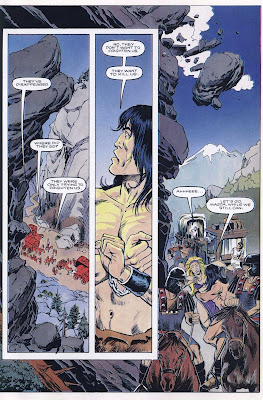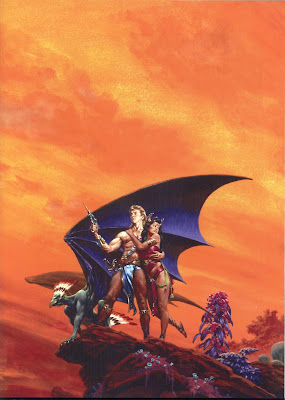The Witch Queen of Acheron
by Don Krarr, Gary Kwapisz, and Art Nichols
Marvel Graphic Novel No. 19, 1985
'The Witch Queen of Acheron' is Marvel Graphic novel No. 19. The story is by Don Kraar, with pencils by Gary Kwapisz, inks by Art Nichols, colors by Julia Ferriter, and letters by Janice Chiang.
As the story opens, our Hero is in familiar surroundings: enjoying the Company of Wenches and Wine in a tavern in Belverus, capital city of Nemedia. However, this episode of hedonism is not destined to last, for Conan is soon imprisoned and threatened with torture and death.
It seems that Prince Tarascus of Nemedia and his mistress Demetzia want something from Conan: the location of a fabled treasure, secreted in a mine somewhere in Acheron, a lawless state in the northern border of Nemedia
Conan not particularly inclined to corroborate with degenerate aristocrats like Tarascus and Demetzia, and makes a break for freedom.
Conan is unsuccessful, and to save his own skin, agrees to lead a major expedition to the mine. The way is fraught with danger, for the wild tribesmen of Acheron don't take kindly to the trespass of strangers.
This being a 1985 graphic novel, the reader is treated to cheesecake images featuring 80s - inspired lingerie / bikini fashions.
I won't disclose any spoilers, save to say that the expedition does eventually find the mine where the treasure is housed. But this is just the start of Conan's troubles.....
I found 'The Witch Queen of Acheron' to be a mediocre graphic novel and Conan adventure. Kraar' script isn't particularly original, treading the same ground as previous Conan adventures.
Gary Kwapisz's artwork is uneven, ranging from very good in one panel, to makeshift in another, a signal that Deadline Issues were cropping up. The coloring of the book also is mediocre, with the darker color schemes leaving the reader forced to peer at the murk in order to make out any details. I can't tell if the book was printed using the World Color plastic-plate flexographic process, but if it was, that might explain this drawback.
Summing up, 'The Witch Queen of Acheron' certainly isn't a must-have for either Conan fans, or fans of 80s graphic novels.














































































